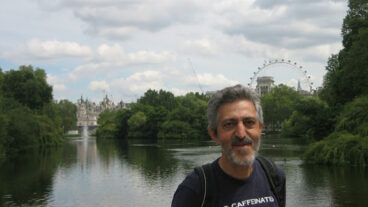Staff at the The Dolphin Reef in Eilat – It’s a lot like taking care of a lot of children.As sunburned tourists stand on the pier that jets out from the shore of the Red Sea Dolphin Reef, clapping and cheering as dolphins jump and swim to greet them.
It’s unclear who group is enjoying the experience more: the humans or the animals.
There is no other nature reserve like it in the world. The Dolphin Reef, in Eilat, Israel’s southernmost point, is a one-of-a-kind ecological site where visitors have the unusual opportunity to meet and observe dolphins in their natural habitat.
The site is operated on a strict philosophy of free will: the dolphins are not forced or bribed to perform or interact with humans – they do so only out of their own desire.
“We decided to do something different with dolphins than had been done anywhere in the world, to treat them with respect and not as circus animals. We wanted to take advantage of the wonderful and special connection they are capable of having with people and see where it would take us,” said Maya Zilber, one of the founders of the facility and its veteran trainer.
The friendliness of the dolphins towards humans has born out the Reef operators’ belief that dolphins can develop a stronger connection with humans based on curiosity, play, and spontaneous interaction.
The Dolphin Reef was created in 1990, with six dolphins, natives of the Black Sea who were at the Severtsov Russian Academy of Science, a research institute. In their new home in Eilat over the past 15 years, they have thrived and mated, building a continually growing family of native-born ‘sabra’ dolphins.
From the very beginning, when the dolphins arrived in Eilat, the managers of the Dolphin Reef decided that their site was going to be different from any other. They strive to keep the life of the dolphins as normal as possible, except, of course, their unusual amount of contact with human beings.
The Dolphin Reef is marked out by a series of nets, but the animals themselves are not enclosed – as opposed to other dolphin performance facilities, where the animals live alone or in pairs in separate holding tanks.
The dolphins, including babies born at the site, maintain their daily routine of hunting, playing, courting and socializing. They are free to choose between human company or to completely ignore the tourists, continuing their daily routine. Happily, the group of 11 dolphins that lives there today seem to be very social.
The dolphins are fed their fish in regularly scheduled feeding sessions that the public can watch and enjoy. Then the trainers engage them in play. If the dolphins are in the mood they will jump and flirt with their trainers and guests: if they aren’t, they swim away.
“We want them to give of themselves out of desire and affection, and not because they are being bribed,” Zilber told ISRAEL21c. “There is no other dolphin site that works this way, where they aren’t asked to perform in exchange for their fish. It’s definitely a lot harder to ask an animal to do something out of their own free will and treating him as an equal: providing with a relaxed and happy quality of life and just enjoying their natural behavior. It isn’t something you can do when you pack hundreds or thousands of people into a stadium for an hour and want the dolphins to put on a show.”
Since the entrance fee to the Reef gives the visitor the ability to stay there all day, all one needs to get a good look at the dolphins is patience. Visitors can get close to the dolphins from the floating piers and observation points, or they can observe the dolphins under the water during special guided swims or dives.
Zilber, who grew up in Haifa and Tel Aviv, “fell in love” with dolphins during her army service in Sharm el Shekh. She then became an expert in the type of dolphin training that she learned she didn’t want to be a part of, training with a Sea World expert and working at the Dolphinarium in Tel Aviv, which held traditional dolphin shows.
She describes life with the dolphins as very demanding – both physically and emotionally.
“It’s a lot like taking care of a lot of children – none of whom are able to talk to you to communicate their needs. You have to watch them closely all day, making sure they are all right, that they are healthy, that they are getting the proper amount of attention, that they are interacting well.”
Each member of the dolphin group has a name and a personality, and those who visit the Reef frequently get to know them and choose their favorites. Their identities and descriptions are posted on a bulletin board at the Reef’s entrance.
Keeping up with their social life is a great deal like following a soap opera, Zilber says, and it is important to keep up with the changes.
“For example, our dolphin Yampa, is now six years old, the age when female dolphins get their first period – Bat Mitzvah time. She is very into the mating dance now, and is flirting with Cindy, the dominant male. She is less into humans than she used to be, and we understand why.
“If I play with Cindy too long, she gets jealous. So I let her spend time with him, I let them go and leave them alone. Anyone who works here has to be up to speed on these developments and behave accordingly. These are really sensitive creatures. If you insult one of them – if they come for a caress and you pay attention to someone else instead, they can get upset and snub you for a month afterwards. There is a lot of talk about the intelligence of dolphins: they have high emotional intelligence as well: they are very complex and very sexual.”
For seven years, from 1994-2001, the Reef initiated a daring experiment called the Open Sea Project. A door was added to the netting around the Reef site allowing the dolphins to leave their home and swim in the Red Sea.
The policy was the ultimate step in realizing the ‘freedom of choice’ philosophy – the dolphins themselves were able to decide whether to stay within the boundaries of the site or to go out to the open sea for as much time as they wished.
“It was scary to let our precious resource out and swim in the sea,” recalls Zilber. “But they always returned home, where they knew they had security, health and food. But it was more important to show the dolphins that they didn’t have to be here. With the project, they learned that this was really their home and that they wanted to be here.”
Unfortunately, the Eilat bay was not a very open sea, but crowded with holiday merrymakers. Zilber says that the Reef couldn’t control the untrained tourists aboard boats who would offer the dolphins food, and try to play with them, which turned out to be problematic.
“After a while, it was like having your kids come home from kindergarten and know they were exposed to bad influences without supervision. They started to behave badly and more aggressively.”
Reluctantly, the gate of the Reef was shut, and the dolphins now stay within the Reef facility.
Last summer, the Reef’s commitment to act on behalf of the dolphins’ quality of life, led them full circle – with a decision to send some of the dolphins back to the Black Sea to help replenish the dolphin population.
When the original group of six dolphins were transferred to Eilat in 1990, the ecological condition of the Black Sea had drastically deteriorated as a result of industrial pollution and fishing, and as a result, the dolphin population there had dwindled reached the verge of extinction.
Thanks to the efforts of the governments of the countries surrounding the Black Sea, and the recognition of the dolphins living in it as an endangered species, over the past five years, the body of water has seen a vast improvement and rejuvenation.
So when the Reef started to get too crowded for the growing clan of dolphins, a decision was made to send two of the Israeli-born dolphins, Shandy, a 10 year old male and Pashosh, a 12 year old female, back to the Black Sea, to the home of their parents.
Flown from Eilat to the Utrish Biological Research Station at the Black Sea, they were first introduced to a pair of local dolphins. After a stay of about one month at the Research Station, and the four dolphins were released into the Black Sea, in a project was backed and accompanied by local and international environmental groups.
The Reef is a busy place, with activities taking place that go beyond entertainment for tourists. In addition to the constant stream of tourists and divers, there are special visitors who come to take part in a therapeutic program entitled ‘Supportive Experience with the Aid of the Dolphins’.
Participants in the program are usually children between 6-16 suffering from many different disorders and diseases: cancer, behavioral problems, sexual abuse, Down’s Syndrome, autism, ADD. ADHD, mental retardation and other issues. Some adults take part was well.
It is a long-term program – on average the child comes for one and half years. They visit for 2 weeks every 2 months for a child coming from Europe, for 4 days of work each week of contact with the dolphins in the water and on land.
“It helps both kids and adults forget all of their problems and pressure, and focus on the dolphins and being in the water, which is in itself a relaxing experience. The dolphin perceives the difference in a human with special needs or deep problems. It’s not exactly therapy, it’s more like a booster shot, showing them a special side of life,” says Zilber.
Scholarly work also takes place there, with courses in dolphin behavior and on conducting dolphin-assisted therapy at their International Research Laboratory, which also offers short courses on dolphin behavior and dolphin-assisted therapy.
A less serious-minded visitor to the Dolphin Reef is its adopted mascot – a dog named Joker who enjoys an unusual friendship with the dolphins.
About five years ago, the fluffy gray dog made his way from his home in Eilat into Dolphin Reef. He kept going down to the pier and gazing at the dolphins, spending hours staring at them. Being curious creatures themselves found him very interesting.
Ultimately, he decided to take the plunge and join the dolphins in the water. From then on, Joker decided to swim with them every day. Each morning, he trots the several miles from his house to the Reef, plays with them all day, and at the end of the day, catches a ride home with one of the staff at the Reef.
Most human visitors to the Reef are like Joker – once they get a taste of spending time with the dolphins, they are eager to come back.












